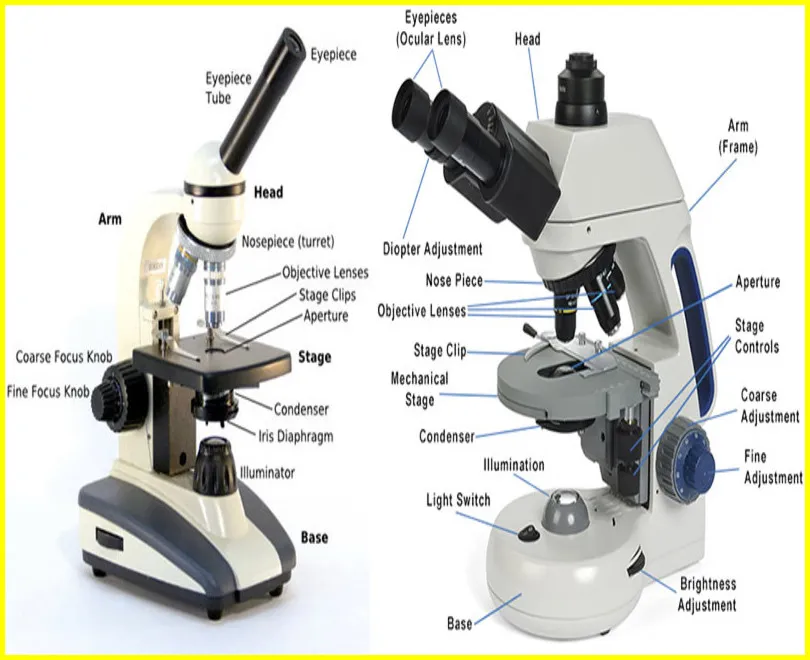
Parts of a Compound Microscope
Parts of a Compound Microscope
Each of the many components that make up a compound microscope has a distinct function in the magnification and observation of microscopic objects. The components of a compound microscope are as follows:
- Eyepiece (Ocular): This is the lens at the top of the microscope that you look through. It typically has a 10x magnification.
- Objective Lenses: These are the primary lenses responsible for magnifying the specimen. Compound microscopes usually have multiple objective lenses with different magnification levels, such as 4x, 10x, 40x, and 100x.
- Revolving Nosepiece (Turret): This is a rotating device that holds the objective lenses. It allows the user to easily switch between different magnifications by rotating the desired objective into position.
- Stage: The flat platform where you place the slide containing the specimen. The stage often has a central opening to allow light to pass through and reach the specimen.
- Stage Clips: These are used to secure the microscope slide in place on the stage.
- Condenser: Located under the stage, the condenser focuses and concentrates the light onto the specimen for better illumination.
- Illuminator: The light source located at the base of the microscope, providing illumination for the specimen.
- Diaphragm: Positioned beneath the stage, the diaphragm controls the amount of light passing through the specimen. It helps in adjusting the contrast and brightness.
- Coarse Adjustment Knob: This larger knob allows for rapid movement of the stage up and down for coarse focusing. It is typically used with low-power objectives.
- Fine Adjustment Knob: This smaller knob is used for fine-tuning the focus on the specimen. It provides more precise control, especially when using higher magnification objectives.
- Arm: The curved part of the microscope that connects the head to the base. It is used for carrying and holding the microscope.
- Base: The bottom part of the microscope that provides stability and support.
Together, these parts allow viewers to examine photographs of tiny specimens that have been greatly enlarged. For in-depth observation and study, the focus, magnification, and lighting settings may be changed.
A microscope is an important tool for scientific study, used to observe and analyze objects that are too small to be seen by the naked eye. Thus, it is important to understand the various components of a microscope and the differences between them – such as the legs, base and pillar. In this article, we will learn what these terms mean and how the parts of a compound microscope affect how the microscope is used.
What is a foot or base?
A foot is the basic unit of measurement in the English system, equal to 12 inches. A plinth is the foundation or lower support of something, such as a column or statue. A pillar is an upright support, often used to support a roof or other structure.
Article About:- Health & fitness
Article About:- Medical Technology
Article About:- Sports

What is a pillar?
A pillar is a supporting structure used to hold a building or other structure upright. Pillars can be made from a variety of materials, including stone, metal or wood.
What is an arm?
An arm is a supporting structure that helps to hold a person or object in place. It can be made of various materials, such as metal, wood or plastic. An arm may be attached to a wall or other surface, or it may be freestanding.
Important parts of a compound microscope and its functions
A compound microscope is a light microscope that uses two or more lenses to magnify an object. The most important parts of a compound microscope are the objective lens, eyepiece, stage, and light source.
The objective lens is the lens which is closest to the object being observed. This is usually a high-powered lens that magnifies the object more than the eyepiece.
Eyepiece is the lens through which you see the image of the object magnified by the objective lens. It usually has less power than the objective lens.
The platform is the platform on which the object being viewed is placed. It usually has a hole in the center so that light can pass through and illuminate the object.
The light source is usually a lamp or LED that shines light on the object being viewed. It illuminates the object so that it can be seen more clearly through a microscope.
FAQ
What are the 12 parts of compound microscope?
Compound Microscopes
Ocular (eyepiece) lens.
Light source, a light or mirror.
Diaphragm or condenser lens.
Stage (to hold the sample)
Objective turret or Revolver (to hold multiple objective lenses)
Objective.
Focus wheel to move the stage.
Frame.
What is a compound microscope Class 12?
Two convex lenses are used to make a compound microscope; one lens is placed close to the eye, while the other is placed close to the object being observed. The ocular lens uses the picture created by the objective lens as an object.
What is compound microscope full detail?
A compound microscope is essentially a high magnification microscope that multiplies the magnification level by two using two lenses. The first lens is known as the objective lens, and its magnification capacity is usually 4x, 10x, 40x, or 100. The eyepiece lens is the name given to the second lens.
What are the advantages of a compound microscope?
Advantages
1. Utilizing and handling a compound light microscope is rather simple.
2. It is easy to store because it is little.
3. In the fields of biological sciences and medicine, it is a priceless instrument.
4. You may see specimen samples in real time using it.
5. When compared to an electron microscope, it is less costly.




